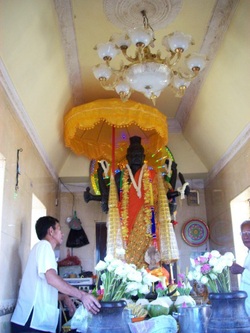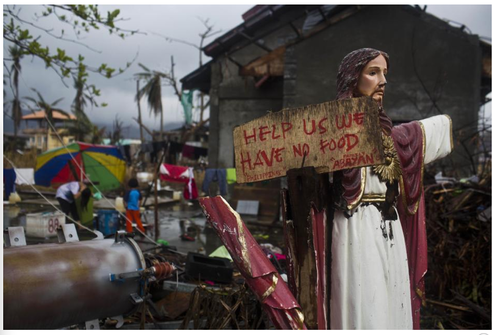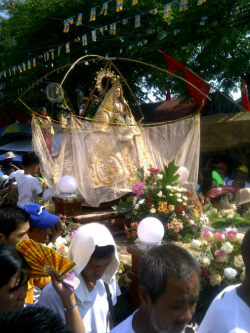
My friend and colleague Dr, Karen Greene (her blog, Unruly Pieces, is just launched) sent me this link from Cambodia Daily, an English-language newspaper out of Phnom Penh. Her sophisticated work reflects on a Khmer cosmological entanglement with the neoliberal politics of abandonment, so she's always on the prowl for "spirited" politics. If you're a tourist to the Royal Palace, or you want to take a promenade along Sisowath Quay, you can't help but pass Preah Ang Dangker (or Preah Ang Dorng Keur), a small shrine clotted with petitioners particularly on the weekend and holidays. Bins are heaped with fresh lotus clusters and coconuts discarded to make way for new bouquets, vendors offer small birds to buy that you can release for merit. The shrine, though close to the palace and riverfront, the major tourist haunt, operates like a parallel universe. In the last year, Preah Ang Dangker has become the Cambodian people's advocate and axis mundi. Miech Ponn, adviser for the Council of Khmer Culture at the Buddhist Institute, reminds us that Preah Ang Dangker would be like the king of the neakta, Cambodia's territorial guardian spirits, and responsible for the whole country. 1 That his shrine faces the royal temple affirms his patronage.
Just last week, his patronage was implored on two counts of injustice. He was asked to effect the curse of displaced Borei Keila villagers and to offer sanctuary to supportive monks and families of 21 jailed garment workers protesting the government's decision to deny them bail. In the first case, Borei Keila villagers were evicted from their homes two years ago in a government deal with Phanimex. While most of the 1,000 residents have been relocated, 150 families are homeless. Last week, twenty of these former residents placed a bowl of soil from their home and lit incense to invoke their spirit ancestors for a solution -- and curse. Pich Limkhuon, their spokesman said, “We wish to curse the people who took our land; their business must be destroyed and they must no longer live in peace, unless the land is returned to us.” 2
The shrine also served as a sanctuary for a stand-off between advocates of garment worker rights and police. On Feburary 21, monks from the Independent Monk Network for Social Justice, and family members protested the court's refusal to offer bail for twenty one garment laborers who were arrested during the garment sector protests last month. Security forces killed four and injured many others. The jailed workers have also been denied access to adequate medical care, lawyers and family members. 3 Ven Buntenh, head of the Independent Monk Network, led prayers for protesters and monks outside Preah Ang Dangker until riot police arrived. He walked across the street towards the police, pledging to immolate himself if the garment workers were not released. But when police reinforcements pushed the monks and protesters back towards the shrine, they dispersed.
Preah Ang Dangker has distinct partisan leanings, since the shrine is the magnetic center for the Cambodia National Rescue Party, the opposition party and only real challenge to the reigning Cambodian People’s Party during last year's election. But Peah Ang Dangker has also been invoked as a peacemaker. Cheang Sokha, executive director of Youth Resource Development Program led a small march of 200 people to pray for peace at Preah Ang Danker, saying, We pray to the God for a peaceful solution to the political deadlock after the July 28 national election." 4
This blog by Jerry Redfern offers gorgeous photos on Khmer interaction with their "Cambodian spirit world" - the last photo depicts the activity in and around Preah Ang Dangker. (He claims that the figure inside the shrine is Avalokitesvara a Mahayana Bodisattava of Compassion who appears throughout Southeast Asia. In Mahayana countries, Avalokitesvara is more popular as Kuan Yin (Guanyin) the female version of this Bodhisattava.) Frank Smith, a fluent Khmer speaker offers a background on shrine is in Khmer.
Footnotes
1. Vong Sokheng, Yath Sal and Choeung Ek's Red-Neck Guardian, Phnom Penh Post, January 27, 2006
2. Aun Pheap and Lauren Crothers Borei Keila Villagers Cast Curse on Adversaries, Cambodia Daily, February 21, 20142.
3. Mech Dara and Colin Meyn , Appeal Court Denies Bail to 21 Jailed Protesters, Cambodia Daily, February 22, 2014
4. People pray for peace as row over Cambodia's poll results heats up, news.xinhuanet.com English.news.cn 2013-08-14 18:11:26



 RSS Feed
RSS Feed
